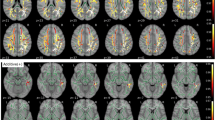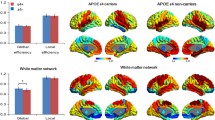Abstract
Alzheimer’s disease (AD) is most commonly detected during old age, but the underlying neuropathologic changes likely appear decades earlier, especially among patients possessing genetic risk factors, such as the isoform E4 of the apolipoprotein E (ApoE4). In this study, we used magnetic resonance imaging (MRI) to assess default mode network (DMN) connectivity in 22 ApoE4 non-carriers and 14 matched ApoE4 carriers as well as white matter fractional anisotropy (FA) in 15 ApoE4 non-carriers and 11 demographically matched ApoE4 carriers. Cognitive tests were also administered. All of the participants were middle-aged adults. The analysis revealed no cognitive or white matter FA differences between carriers and non-carriers. However, in DMN regions previously implicated in AD, we did detect decreased functional connectivity. Our findings suggest that functional MRI abnormalities may be detectable well before cognitive decline or white matter changes among individuals at increased genetic risk for AD.


Similar content being viewed by others
References
Axelrod, B. N., & Ryan, J. J. (2000). Prorating Wechsler adult intelligence scale-III summary scores. Journal of Clinical Psychology, 56(6), 807–811.
Behrens, T. E., Woolrich, M. W., Jenkinson, M., Johansen-Berg, H., Nunes, R. G., Clare, S., et al. (2003). Characterization and propagation of uncertainty in diffusion-weighted MR imaging. Magnetic Resonance in Medicine, 50(5), 1077–88.
Bell, A. J., & Sejnowski, T. J. (1995). An information-maximization approach to blind separation and blind deconvolution. Neural Computation, 7(6), 1129–1159.
Binnewijzend, M. A, Schoonheim, M. M., Sanz-Arigita, E., Wink, A. M., van der Flier, W. M., Tolboom, N., et al. (2011). Resting-state fMRI changes in Alzheimer’s disease and mild cognitive impairment. Neurobiology of Aging.
Calhoun, V. D., Adali, T., Pearlson, G. D., & Pekar, J. J. (2001). A method for making group inferences from functional MRI data using independent component analysis. Human Brain Mapping, 14(3), 140–151.
Cherner, M., Suarez, P., Lazzaretto, D., Fortuny, L. A., Mindt, M. R., Dawes, S., et al. (2007). Demographically corrected norms for the Brief Visuospatial Memory Test-revised and Hopkins Verbal Learning Test-revised in monolingual Spanish speakers from the U.S.-Mexico border region. Archives of Clinical Neuropsychology, 22(3), 343–353.
Damoiseaux, J. S., Prater, K. E., Miller, B. L., & Greicius, M. D. (2011). Functional connectivity tracks clinical deterioration in Alzheimer’s disease. Neurobiology of Aging.
Delis, D., Kaplan, E., & Kramer, J. (2001). Delis Kaplan executive function system. San Antonio: The Psychological Corporation.
Filippini, N., MacIntosh, B. J., Hough, M. G., Goodwin, G. M., Frisoni, G. B., Smith, S. M., et al. (2009). Distinct patterns of brain activity in young carriers of the APOE-epsilon4 allele. Proceedings of the National Academy of Sciences of the United States of America, 106(17), 7209–7214.
Filippini, N., Ebmeier, K. P., MacIntosh, B. J., Trachtenberg, A. J., Frisoni, G. B., Wilcock, G. K., et al. (2011). Differential effects of the APOE genotype on brain function across the lifespan. NeuroImage, 54(1), 602–610.
Fleisher, A. S., Sherzai, A., Taylor, C., Langbaum, J. B., Chen, K., & Buxton, R. B. (2009). Resting-state BOLD networks versus task-associated functional MRI for distinguishing Alzheimer’s disease risk groups. NeuroImage, 47(4), 1678–1690.
Greicius, M. D., Srivastava, G., Reiss, A. L., & Menon, V. (2004). Default-mode network activity distinguishes Alzheimer’s disease from healthy aging: evidence from functional MRI. Proceedings of the National Academy of Sciences of the United States of America, 101(13), 4637–4642.
Hampel, H., Prvulovic, D., Teipel, S. J., & Bokde, A. L. (2011). Recent developments of functional magnetic resonance imaging research for drug development in Alzheimer’s disease. Progres in Neurobiology.
He, Y., Wang, L., Zang, Y., Tian, L., Zhang, X., Li, K., et al. (2007). Regional coherence changes in the early stages of Alzheimer’s disease: a combined structural and resting-state functional MRI study. NeuroImage, 35(2), 488–500.
Heise, V., Filippini, N., Ebmeier, K. P., & Mackay, C. E. (2011). The APOE varepsilon4 allele modulates brain white matter integrity in healthy adults. Molecular Psychiatry, 16(9), 908–916.
Honea, R. A., Vidoni, E., Harsha, A., & Burns, J. M. (2009). Impact of APOE on the healthy aging brain: a voxel-based MRI and DTI study. Journal of Alzheimer’s Disease, 18(3), 553–564.
Jenkinson, M., & Smith, S. (2001). A global optimisation method for robust affine registration of brain images. Medical Image Analysis, 5(2), 143–156.
Klein, C., Hagenah, J., Landwehrmeyer, B., Munte, T., & Klockgether, T. (2011). The presymptomatic stage of neurodegenerative disorders. Nervenarzt, 82(8), 994–1001.
Klove, H. (1963). Clinical Neuropsychology. In F. M. Forster (Ed.), Medical clinics of North America. New York: Saunders.
Li, Y. O., Adali, T., & Calhoun, V. D. (2007). Estimating the number of independent components for functional magnetic resonance imaging data. Human Brain Mapping, 28(11), 1251–1266.
Likitjaroen, Y., Meindl, T., Friese, U., Wagner, M., Buerger, K., Hampel, H. et al. (2011). Longitudinal changes of fractional anisotropy in Alzheimer’s disease patients treated with galantamine: a 12-month randomized, placebo-controlled, double-blinded study. European Archives of Psychiatry and Clinical Neuroscience.
Lind, J., Persson, J., Ingvar, M., Larsson, A., Cruts, M., Van Broeckhoven, C., et al. (2006). Reduced functional brain activity response in cognitively intact apolipoprotein E epsilon4 carriers. Brain, 129(Pt 5), 1240–1248.
Liu, Y., Wang, K., Yu, C., He, Y., Zhou, Y., Liang, M., et al. (2008). Regional homogeneity, functional connectivity and imaging markers of Alzheimer’s disease: a review of resting-state fMRI studies. Neuropsychologia, 46(6), 1648–1656.
Medina, D., DeToledo-Morrell, L., Urresta, F., Gabrieli, J. D., Moseley, M., Fleischman, D., et al. (2006). White matter changes in mild cognitive impairment and AD: A diffusion tensor imaging study. Neurobiology of Aging, 27(5), 663–672.
Nichols, T. E., Holmes, A. P. (2001). Nonparametric permutation tests for functional neuroimaging: a primer with examples. Hum Brain Mapp 15, 1–25.
Raichle, M. E., MacLeod, A. M., Snyder, A. Z., Powers, W. J., Gusnard, D. A., & Shulman, G. L. (2001). A default mode of brain function. Proceedings of the National Academy of Sciences of the United States of America, 98(2), 676–682.
Randolph, C. (1998). Repeatable Battery for the Assessment of Neuropsychological Status (RBANS): Test manual. San Antonio: Harcourt Brace and Company.
Reiman, E. M., Chen, K., Alexander, G. E., Caselli, R. J., Bandy, D., Osborne, D., et al. (2004). Functional brain abnormalities in young adults at genetic risk for late-onset Alzheimer’s dementia. Proceedings of the National Academy of Sciences of the United States of America, 101(1), 284–289.
Reitan, R. M. (1958). Validity of the Trail Making Test as an indi- cator of organic brain damage. Perceptual and Motor Skills, 8, 271–276.
Rombouts, S. A., Barkhof, F., Goekoop, R., Stam, C. J., & Scheltens, P. (2005). Altered resting state networks in mild cognitive impairment and mild Alzheimer’s disease: an fMRI study. Human Brain Mapping, 26(4), 231–239.
Ryan, J. J., & Schnakenberg-Ott, S. D. (2003). Scoring reliability on the Wechsler Adult Intelligence Scale-Third Edition (WAIS-III). Assessment, 10(2), 151–159.
Sheline, Y. I., Morris, J. C., Snyder, A. Z., Price, J. L., Yan, Z., D’Angelo, G., et al. (2010). APOE4 allele disrupts resting state fMRI connectivity in the absence of amyloid plaques or decreased CSF Abeta42. Journal of Neuroscience, 30(50), 17035–17040.
Smith, S. M. (2002). Fast robust automated brain extraction. Human Brain Mapping, 17(3), 143–155.
Smith, S. M., & Nichols, T. E. (2009). Threshold-free cluster enhancement: addressing problems of smoothing, threshold dependence and localisation in cluster inference. NeuroImage, 44(1), 83–98.
Smith, S. M., Jenkinson, M., Johansen-Berg, H., Rueckert, D., Nichols, T. E., Mackay, C. E., et al. (2006). Tract-based spatial statistics: voxelwise analysis of multi-subject diffusion data. NeuroImage, 31(4), 1487–1505.
Spampinato, M. V., Rumboldt, Z., Hosker, R. J., & Mintzer, J. E. (2011). Apolipoprotein E and gray matter volume loss in patients with mild cognitive impairment and Alzheimer disease. Radiology, 258(3), 843–852.
Trachtenberg, A. J., Filippini, N., Ebmeier, K. P., Smith, S. M., Karpe, F., & Mackay, C. E. (2012). The effects of APOE on the functional architecture of the resting brain. NeuroImage, 59(1), 565–572.
Wang, L., Zang, Y., He, Y., Liang, M., Zhang, X., Tian, L., et al. (2006). Changes in hippocampal connectivity in the early stages of Alzheimer’s disease: evidence from resting state fMRI. NeuroImage, 31(2), 496–504.
Wang, K., Liang, M., Wang, L., Tian, L., Zhang, X., Li, K., et al. (2007). Altered functional connectivity in early Alzheimer’s disease: a resting-state fMRI study. Human Brain Mapping, 28(10), 967–978.
Ward, B. D. (2000). Simultaneous inference for FMRI data.
Westlye, E. T., Lundervold, A., Rootwelt, H., Lundervold, A. J., & Westlye, L. T. (2011). Increased hippocampal default mode synchronization during rest in middle-aged and elderly APOE epsilon4 carriers: relationships with memory performance. Journal of Neuroscience, 31(21), 7775–7783.
Wilkinson, G. S. (1993). The wide range achievement test: Manual (3rd ed.). Wilmington, DE: Wide Range.
Zhang, Y., Schuff, N., Jahng, G. H., Bayne, W., Mori, S., Schad, L., et al. (2007). Diffusion tensor imaging of cingulum fibers in mild cognitive impairment and Alzheimer disease. Neurology, 68(1), 13–19.
Zhang, H. Y., Wang, S. J., Xing, J., Liu, B., Ma, Z. L., Yang, M., et al. (2009). Detection of PCC functional connectivity characteristics in resting-state fMRI in mild Alzheimer’s disease. Behavioural Brain Research, 197(1), 103–108.
Zhang, H. Y., Wang, S. J., Liu, B., Ma, Z. L., Yang, M., Zhang, Z. J., et al. (2010). Resting brain connectivity: changes during the progress of Alzheimer disease. Radiology, 256(2), 598–606.
Acknowledgements
This research was supported by a research grant from the Connecticut Department of Public Health (Principal Investigator—Lance Bauer, Ph.D., University of Connecticut). Additional support was provided by Public Health Service grant M01RR006192.
Disclosure statement
All authors have no conflicts of interest to disclose.
Author information
Authors and Affiliations
Corresponding author
Rights and permissions
About this article
Cite this article
Patel, K.T., Stevens, M.C., Pearlson, G.D. et al. Default mode network activity and white matter integrity in healthy middle-aged ApoE4 carriers. Brain Imaging and Behavior 7, 60–67 (2013). https://doi.org/10.1007/s11682-012-9187-y
Published:
Issue Date:
DOI: https://doi.org/10.1007/s11682-012-9187-y




